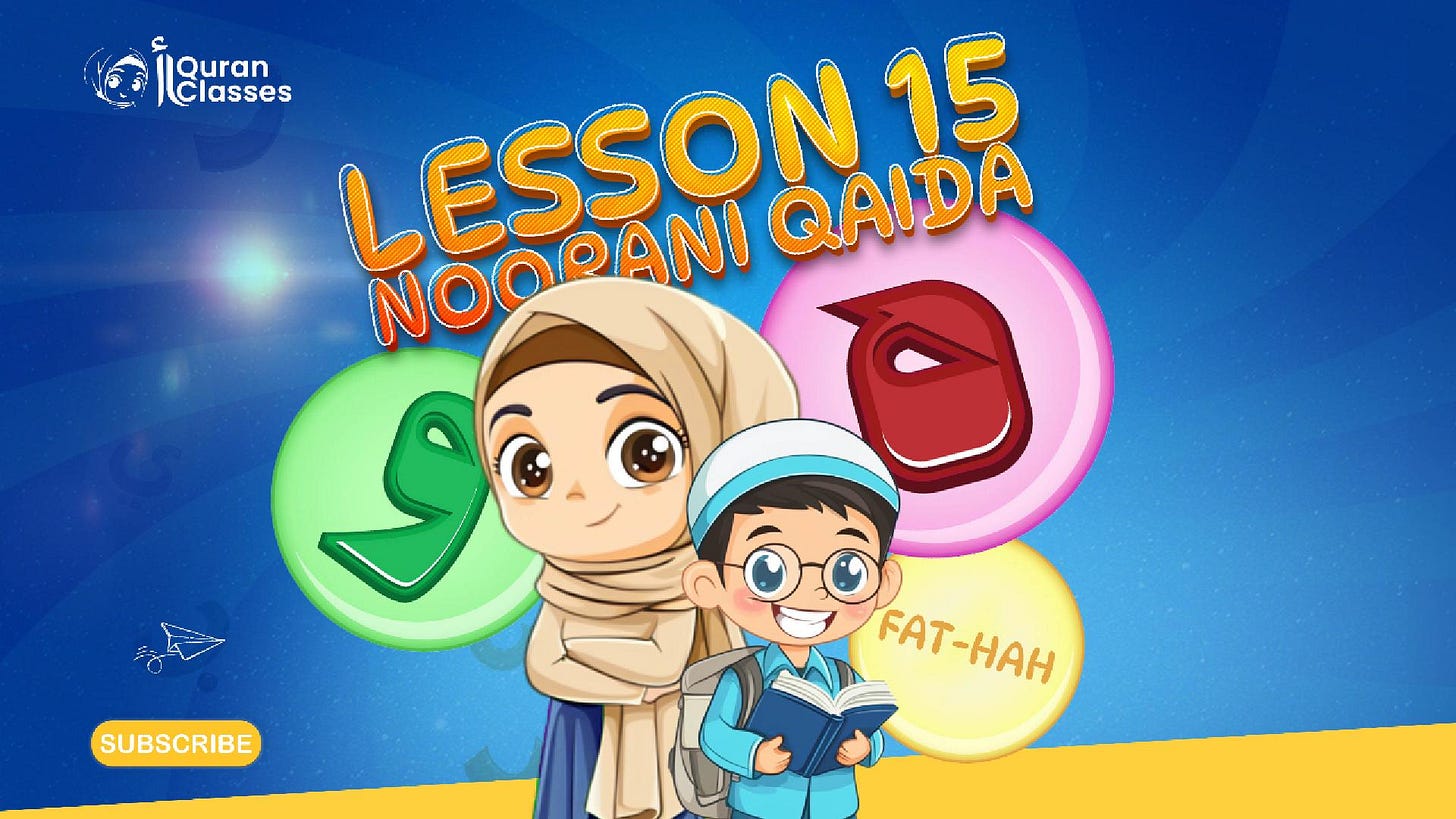Bayt Al-Quran: Noorani Qaida-Lesson#15|Monday
Introducing the Letters هَ and وَ with Fathah
Welcome to Lesson 15, dear students! Today, we will discover two special letters of the Arabic alphabet—haa (هـ) and waaw (و)—with the short vowel Fathah (َ). These letters may seem small, but they are packed with personality, beauty, and precision.
Let’s begin with haa (هـ). This letter is known for its light, breathy sound, which is produced from deep inside the throat. It's like a gentle whisper or the soft sound of air passing through. When we say "هَ" (ha), we’re not using the tongue or the lips—just a gentle flow of breath from the throat. This teaches us how to control our voice and how to stay calm and clear in pronunciation. Haa reminds us that sometimes, even the softest sounds can have the most beautiful impact in recitation.
Now let’s meet the waaw (و). This letter is quite different! It comes from the lips, and it’s known for being smooth, round, and musical. It almost feels like a little wave when we say "وَ" (wa)—the lips come together gently and then open with a soft burst of sound. With waaw, we practice lip movement and clarity, making sure our sounds are flowing and neat.
Both these letters become bright and expressive when we add the Fathah, which gives a short “a” sound to the letter. So today, you’ll be learning how to pronounce "هَ" (ha) and "وَ" (wa) with clarity, beauty, and proper technique.
These letters also appear frequently in the Quran, so learning them well now will help you become more confident and fluent as you continue your journey. Let’s get ready to explore their unique sounds, practice them with focus, and recite them the way they were meant to be heard—in the most beautiful and correct way, In sha Allah!
Learning Key Points of This Lesson:
Focused Introduction to هَ and وَ Sounds
This lesson introduces children to the correct pronunciation and recognition of the Arabic letters هَ (Haa with Fathah) and وَ (Waw with Fathah). It builds a strong foundation for Arabic phonics and early reading development.
Exploring Letter Connections in Words
Children discover how هَ and وَ change their forms when connected to other letters in Arabic words. They learn to recognize these letters in the beginning, middle, and end of words, which improves their reading fluency.
Writing and Pronunciation Practice
With guided tracing and pronunciation drills, students learn how to properly write هَ and وَ and pronounce them clearly and confidently.
Sound Repetition for Memory Strengthening
Repetition is key to retention. Children engage in repeated listening and speaking exercises to strengthen their memory of the هَ and وَ sounds.
Visual Learning with Flashcards
Colorful flashcards associate each letter—هَ and وَ—with a familiar word or image, making the learning process fun and memorable through visual association.
Word Building Using هَ and وَ
Kids create and read simple Arabic words using هَ and وَ, combining them with letters they've already learned to build vocabulary and confidence in reading.
Letter Recognition Through Playful Activities
Interactive games and playful activities help children easily recognize هَ and وَ in different environments and written contexts.
Learning Through Stories
Short Arabic stories featuring words that include هَ and وَ offer real-world usage. Simple English translations help children understand meanings and improve bilingual learning.
Printable Worksheets for Home Practice
Printable take-home worksheets allow children to trace, write, and review هَ and وَ, supporting independent learning outside the classroom.
🎥 Watch Today’s Lesson Video:
Time to Explore هَ and وَ!
Print your activity sheet, grab your brightest crayons or markers, and let’s bring these two letters to life!
هَ (Haa with Fathah) whispers a soft “ha!” like a gentle breeze, while وَ (Waaw with Fathah) goes “wa!” like a joyful wave.
They’re easy to say and full of fun. Just a few playful minutes each day will help these sounds become your new favorites.
Playful Activities
1. "Blow the Sound" Game (for Haa هَ)
Objective: Help children feel how haa comes from the throat using breath.
Instructions:
Give each student a small cotton ball or a feather.
Ask them to place it on the table and gently try to blow it forward using the sound "هَ" (not just air).
The challenge is to move the cotton with their voice and breath together, not by just blowing silently.
2. "Lip Pop" Challenge (for Waaw وَ)
Objective: Practice the lip movement needed for waaw.
Instructions:
Ask the children to pretend to kiss the air, then say "وَ" while opening their lips in a round, exaggerated way.
Turn it into a mirror game—let them look into a mirror while saying "وَ" five times and watch how their lips move.
Add silly fun: every time they get it right, they can make a "pop" sound and laugh!
3. Color & Match: Sound Safari
Objective: Reinforce recognition of the letters هَ and وَ in a visual and active way.
Instructions:
Create a worksheet with colorful objects or animals, some that start with or contain haa or waaw.
Example: هَـلَكَ (he perished), وَردَة (flower).Have the children color only the pictures that begin with "هَ" or "وَ" sounds.
Bonus: Play a "letter detective" game where they have to find and circle هَ or وَ in a short verse or word line.
Lesson #15 – Skills Practiced:
Visual recognition, word decoding, and sound categorization.
How did your child enjoy Lesson 14? We’d love to hear about it! Drop a quick note in the comments or share a picture of their worksheet—Teacher Noura would be thrilled to see their progress and send a special word of encouragement, inshaAllah.
Each lesson strengthens their confidence and deepens their bond with the Arabic alphabet. You're doing an amazing job guiding them—keep the momentum going, one joyful step at a time!



